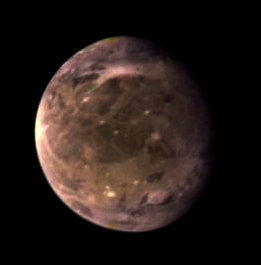
 Ganymede. This view is showing Ganymede, a moon of Jupiter. Ganymede is one of the four Galilean moons of Jupiter -named for Galileo Galilei who first saw them, and the second largest in the solar system. It's a world of its own, with a marbled and patchy, chocolate-tints surface where the darker terrain is the most ancient, as the lighter the youngest. Like three of the four main satellites of Jupiter, Ganymede is part ice-part rock. The whitish patches are the marks of impact-created craters, some of them with ray systems as the whole moon is resurfaced by a mix of plate tectonics and icy volcanism. Jupiter's system has already been thorougfully visited twice by the missions Voyager in the end of the 1970's and beginning of the 1980's, and the Galileo orbiter, 1989-2003, as a third mission, JIMO (for "Jupiter Icy Moons Orbiter"), using the latest and most advanced NASA technologies for propulsion and data gathering, is scheduled to launch in 2012. Like Europa or Callisto, Ganymede might be a good candidate where life might have appeared in our solar system. This picture was taken by Voyager 1, in March 1979, at a range of 2.1 million miles (3.4 million km). picture JPL
Ganymede. This view is showing Ganymede, a moon of Jupiter. Ganymede is one of the four Galilean moons of Jupiter -named for Galileo Galilei who first saw them, and the second largest in the solar system. It's a world of its own, with a marbled and patchy, chocolate-tints surface where the darker terrain is the most ancient, as the lighter the youngest. Like three of the four main satellites of Jupiter, Ganymede is part ice-part rock. The whitish patches are the marks of impact-created craters, some of them with ray systems as the whole moon is resurfaced by a mix of plate tectonics and icy volcanism. Jupiter's system has already been thorougfully visited twice by the missions Voyager in the end of the 1970's and beginning of the 1980's, and the Galileo orbiter, 1989-2003, as a third mission, JIMO (for "Jupiter Icy Moons Orbiter"), using the latest and most advanced NASA technologies for propulsion and data gathering, is scheduled to launch in 2012. Like Europa or Callisto, Ganymede might be a good candidate where life might have appeared in our solar system. This picture was taken by Voyager 1, in March 1979, at a range of 2.1 million miles (3.4 million km). picture JPL
Website Manager: G. Guichard, site 'Amateur Astronomy,' http://stars5.6te.net. Page Editor: G. Guichard. last edited: 12/28/2010. contact us at ggwebsites@outlook.com

